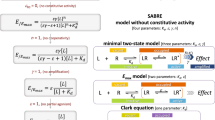Abstract
The “pharmacological dogma” that competitive antagonists cause parallel shifts to the right with sustained maximum effect of semi-logarithmic concentration-response curves of exogenous agonists may not be true if an endogenous agonist is present in the preparation. In this case, the antagonist and the exogenous agonist interfere in a complex way with an existing circuit of regulation between the response and the endogenous agonist. In consequence, it is difficult to determine the true shift in the concentration-response curves as induced by the antagonist, since a deviation of the curves in a non-parallel manner can be observed. The extent of this deviation may be used to learn more about the variables involved.
The present paper discusses this phenomenon: The regulatory circuit of the (auto)receptor modulated release of neutrotransmitters is used as an example. Paired samples of data are analysed in this example. Since the extent of the non-parallel deviation also depends on the manner in which the paired samples are mathematically linked, two different ways of data evaluation have been used. A theoretical model of the relation between receptor activation and response is proposed which allows to evaluate experimental concentration-response curves by means of non-linear regression analysis. This evaluation yields quantitative information on the parameters of the regulatory circuit: the concentration of the endogenous agonist, itsK D value and the true shift of the concentration-response curve caused by the applied antagonist.
Similar content being viewed by others
References
Ariens EJ (1964) Molecular pharmacology, vol 1. Academic Press, New York
Bonanno G, Maura G, Raiteri M (1986) Pharmacological characterization of release-regulting serotonin autoreceptors in rat cerebellum. Eur J Pharmacol 126:317–321
Clark AJ (1937) General pharmacology. In: Heubner W, Schüller J (eds) Handbuch der Experimentellen Pharmakologie, vol IV. Springer, Berlin, Heidelberg New York
Engel G, Göthert M, Hoyer D, Schlicker E, Hillenbrand K (1986) Identity of inhibitory presynaptic 5-hydroxytryptamine (5-HT) autoreceptors in the rat brain cortex with 5-HT1B binding sites. Naunyn-Schmiedeberg's Arch Pharmacol 332:1–7
Feuerstein TJ, Lupp A, Hertting G (1987) The serotonin (5-HT) autoreceptor in the rabbit hippocampus: role of 5-HT biophase concentration (in press)
Fredholm BB, Dunwidie TV, Bergman B, Lindström K (1984) Levels of adenosine and adenine nucleotides in slices of rat hippocampus. Brain Res 295:127–136
Furchgott RF (1972) The classification of adrenoceptors (adrenergic receptors). An evaluation from the standpoint of receptor theory. In: Blaschko H, Muscholl E (eds) Catecholamines. Springer, Berlin, Heidelberg New York (Handbook of experimental pharmacology, vol XXXIII, pp 283–335)
Goldstein A, Aronow L, Kalman SM (1968) Principles of drug action, the basis of pharmacology. Hoeber Medical Division. Harper & Row, New York London
Hedler L, Starke K, Steppeler A (1983) Release of (3H)-amezinium from cortical noradrenergic axons: a model for the study of the α-autoreceptor hypothesis. Br J Pharmacol 78:645–653
Starke K (1981) Presynaptic receptors. Annu Rev Pharmacol Toxicol 21:7–30
Starke K, Montel H, Gayk W, Merker R (1974) Comparison of the effects of clonidine or pre-and postsynaptic adrenoceptors in the rabbit pulmonary artery. Naunyn-Schmiedeberg's Arch Pharmacol 285:133–150
Straus OH, Goldstein A (1943) Zone behavior of enzymes. J Gen Physiol 26:559–579
Author information
Authors and Affiliations
Rights and permissions
About this article
Cite this article
Feuerstein, T.J., Bammert, J. & Meyer, D.K. Endogenous agonists may change the concentration-response curves of exogenous agonists: Source of quantitative information about the endogenous tone. Biol. Cybernetics 56, 419–429 (1987). https://doi.org/10.1007/BF00319521
Received:
Issue Date:
DOI: https://doi.org/10.1007/BF00319521




